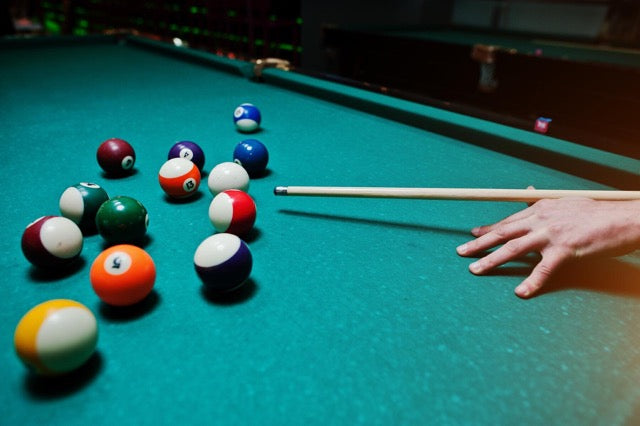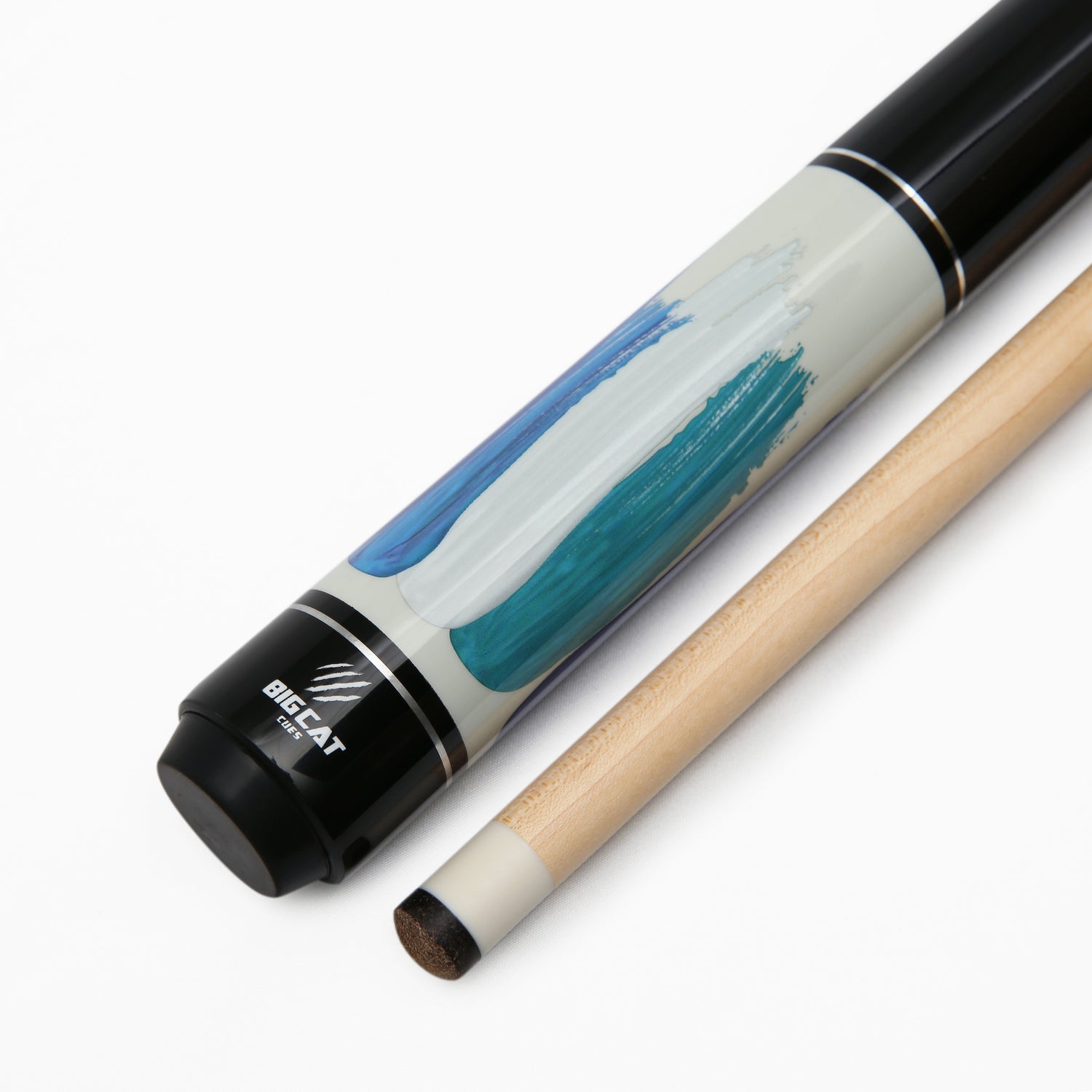
Break Cue vs Playing Cue: Understanding the Key Differences
Key Takeaways
-
A break cue with 18oz that has a harder tip and stiff shaft is designed to deliver explosive energy during the break shot. Learn more about how a break cue can improve your pool breaks in the full article.
-
A playing cue is lighter, with a softer tip and a more flexible shaft. It’s ideal for precision shots, applying spin, and executing strategic gameplay throughout the match. Explore the benefits of a well-designed playing cue below.
-
Using a break cue for powerful starts and a playing cue for finesse and accuracy ensures both tools perform at their best and last longer. Find out in detail the difference between break cue vs playing cue.

Break Cue vs Playing Cue
Discover the durable quality and best budget cues to enhance your game at Big Cat Cues.
What Is A Break Cue?
A break cue is a specialized pool cue designed specifically for the powerful first shot in a game of pool or billiards, known as the "break."
The primary purpose of a break cue is to deliver maximum force and control to scatter the balls effectively, giving the player a strong start.
It’s a crucial tool for players who want to optimize their game and protect their regular playing cue from wear and tear during the high-impact break shot.
Benefits of A Break Cue
Using a break cue can substantially enhance your pool gameplay, especially with the best break cue that fits your style. Here are its benefits:
1. More Power on the Break
Accelerating faster through the balls, a break cue has a similar weight to a regular playing cue but is designed to deliver maximum power for your break shot. This weight helps you hit the cue ball with greater energy, creating a stronger and more explosive break.
With the right technique, this power scatters the balls across the table, giving you a better chance at an open shot. You might even pocket a ball right away, putting you at an immediate advantage.

A break cue gives more power on the break. Source: Pearson Cues
2. Better Control and Accuracy
While power is important, control is key. Break cues are specifically designed to improve accuracy. The firmer tip and carefully balanced weight ensure a stable, controlled hit, so the cue ball is more likely to go exactly where you want.
A precise strike on the rack’s head ball can lead to a favorable layout, setting you up for an easier run in the game.
See more: 9 Best Budget Pool Cue Choices for Beginners Under $200
3. Protects Your Regular Cue
Break shots are high-impact and can cause wear and tear on a regular playing cue, especially on the softer tips and shaft. Using a break cue helps preserve your playing cue for the finest shots it’s meant for, like accurate spins and gentle strokes.
By separating the heavy-duty break from regular play, both cues last longer and perform better.
4. Improved Ball Spread
Break cues are meant to create an effective spread of balls. They offer features like the harder tip and extra weigh tthat are designed to transfer energy efficiently, ensuring the balls scatter well across the table.
This improved distribution means fewer clusters, more shot opportunities, and a smoother flow to the game. A clean break can make the difference between a challenging table and one ready for pool players to dominate.
See more: 8 Best Pool Cues For Advanced Players To Consider For Your Next Game
5. Boosts Confidence
Having a tool specifically made for breaking can give you a mental edge. When you step up to the table, you know your break cue is designed to handle the task without damaging your playing cue.
This peace of mind lets you focus on your technique and execute a powerful, professional break that possibly intimidates your opponent and sets the tone for the rest of the game.
What Is a Playing Cue?
A regular playing cue is the main tool you’ll use for most shots in a game of pool. It’s made for precision, control, and finesse, which makes it super versatile for all kinds of shots.

A regular playing cue. Source: Big Cat Cues
Unlike a break cue that’s built for power, a professional pool cue helps you focus on accuracy and strategy by:
-
Balancing Weight: A playing cue is carefully weighted so it feels steady and smooth when you take a shot. This balance makes it easier to aim and control your movements.
-
Flexible Shaft: The shaft of a playing cue has some flexibility, unlike the stiff shaft of a break cue. This flexibility helps you put a spin, or "English," on the cue ball, which is important for controlling where it goes and setting yourself up for the next shot.
-
Softer Tip: The tip of a playing cue is softer, which grips the cue ball better. This makes it easier to apply spin and control the ball’s direction more precisely, especially on tricky shots.
-
Versatility A playing cue is great for all kinds of shots, whether you’re controlling where the cue ball lands for your next move or adding spin to guide the cue ball exactly where you want it to go.
-
Everyday Use: This is the cue you’ll use the most. Whether you’re making simple shots or planning a clever strategy, your playing cue is your go-to for almost every part of the game.
Key Differences Between Break Cue vs Playing Cue
Then, what is different about break cue vs playing cue?
A break cue (or breaking cue) and a playing cue are designed with specific purposes in mind, and each has unique features to match its role in a game of pool.
1. Purpose
The purposes of breaking vs playing cue serve different types of pool gameplay.
While a playing cue is more for everyday games, a break cue is designed more specifically for breaking shots.
It is to deliver a powerful break shot that spreads the balls across the table. Once the break is complete, the playing cue takes over, being used for most of the game. Ultimately, its role is to handle precision shots, spins, and strategic positioning.
2. Size and Weight
When comparing the size and weight between a break cue vs playing cue, the break cue is typically heavier, from 18-21 ounces. This extra weight helps create a forceful break that scatters the balls effectively.
A playing cue, in contrast, is more balanced, usually weighing around 19 ounces, prioritizing control and precision for smoother and more accurate strokes.

A playing cue is heavier than a break cue. Source: Billiards Forum
3. Tip Hardness
The tips on a breaking cue vs playing cue are noticeably different.
A break cue has a hard tip, often made of phenolic material, to transfer maximum energy to the cue ball without damage.
On the other hand, a playing cue has a softer pool cue tip, which grips the cue ball better. This makes it easier to apply spin and control the ball’s direction for precise shots.
4. Shaft Stiffness
Break cue vs playing cue offers a unique level of shaft stiffness.
The shaft of a break cue is stiff, minimizing flex to ensure that energy transfers efficiently during the break shot. This stiffness is ideal for explosive breaks but less suitable for finesse.
Meanwhile, a playing cue has a more flexible shaft, allowing players to generate spin (or "English") and make delicate, controlled shots.
5. Build
Comparing break cue vs playing cue, the break cue is built sturdier, with a thicker shaft and larger butt for durability and a solid grip.
A playing cue, by contrast, is lighter, slimmer, and designed for smooth strokes and controlled movements.
6. Tips and Ferrules
The tips and ferrules differ in a breaking cue vs playing cue comparison. A break cue’s hard tip offers durability for high-impact shots but doesn’t hold chalk well. Its ferrule is shorter and made of shock-absorbing materials like carbon fiber.
In contrast, a playing cue has a softer tip that retains chalk better for spin control, and its longer ferrule provides balance and absorbs shock for finesse shots.
Here is a comparison table between break cue vs playing cue:
|
Factor |
Break Cue (Breaking Cue) |
Playing Cue |
|
Tip |
Hard phenolic tip for powerful, durable breaks. |
Soft tip for better chalk retention and precise spin control. |
|
Ferrule |
Short, shock-absorbing ferrule made of carbon fiber. |
Longer ferrule made of softer materials for balance and grip. |
|
Shaft |
Stiff shaft to reduce flex and maximize energy transfer. |
Flexible shaft for generating spin and controlled shots. |
|
Weight |
Heavier (18-21 ounces) for a solid and forceful break. |
More balanced (around 19 ounces) for accuracy and precision. |
|
Purpose |
Designed to deliver an explosive break shot. |
Used throughout the game for strategic and controlled play. |
|
Build |
Sturdier with a thicker shaft and larger butt for impact. |
Slimmer with a slender shaft and thinner butt for finesse. |
Can You Use One Cue for Both?
Yes, you can use one cue for both breaking and playing, but it’s not always ideal.
Let Big Cat gives you a breakdown of the pros and cons, how it might affect your game, and when a dual-purpose cue could work.
1. Pros of Using One Cue for Both
Using a single cue simplifies things as you don’t need to carry or invest in two separate cues. It’s also more convenient for casual games or if you’re just starting out and don’t want to overthink your equipment.
For many beginner or intermediate pool cue players, one cue is enough to handle both the break and regular shots reasonably well.
2. Cons of Using One Cue for Both
However, using both at once has trade-offs.
Breaking with your regular playing cue can cause wear and tear, especially on the softer tip, which isn’t designed to handle the force of a break shot. Over time, this could lead to a flattened or damaged tip, making it harder to execute spin or precise shots during regular play.
Additionally, a typical playing cue’s weight and flexibility aren’t optimized for breaking, which may result in a less powerful and effective break.

Using a playing cue for a breaking shot can damage the cue tip
3. How Using the Wrong Cue Can Affect Your Game
Break cue vs playing cue aren’t interchangeable. Each cue has different purposes and uses for specific gameplay.
If you use a break cue for regular shots, its hard tip and stiff shaft can make it challenging to apply spin or finesse to your shots, leading to less control and accuracy.
On the other hand, using a playing cue for breaking can lead to a weak break, reducing your chances of spreading the balls effectively, and could damage your cue over time, affecting its performance for the rest of the game.


